Table of Contents
ToggleIntroduction
The world has witnessed a surge in the emergence of new infectious diseases in recent years. From SARS, MERS, and Ebola to COVID-19, the impacts of these diseases have been enormous, causing significant morbidity and mortality, disrupting economies and societies, and posing significant challenges to public health systems worldwide. In this article, we will explore the causes, impacts, and prevention strategies for the emergence and spread of new infectious diseases.
Causes of Emergence and Spread of New Infectious Diseases
The emergence and spread of new infectious diseases are complex phenomena that result from a combination of factors, including:
Environmental factors: Climate change, deforestation, and changes in land use can lead to the displacement of animals and their pathogens, creating new opportunities for animal-to-human transmission of infectious diseases. For example, the Ebola virus is believed to have originated from bats, while the Nipah virus is transmitted from fruit bats to humans.
Globalization: The movement of people, goods, and animals across borders has facilitated the spread of infectious diseases. International travel and trade have enabled the rapid transmission of infectious diseases across continents, as was seen with SARS and COVID-19.
Antimicrobial resistance: The overuse and misuse of antibiotics have led to the emergence of drug-resistant strains of bacteria, making it difficult to treat infectious diseases.
Poor hygiene and sanitation: Poor hygiene and sanitation practices, especially in low-income countries, can create breeding grounds for infectious diseases. Lack of access to clean water and sanitation facilities increases the risk of waterborne diseases, such as cholera and typhoid fever.
Impacts of New Infectious Diseases
The impacts of new infectious diseases can be significant and far-reaching. These include:
Public health: New infectious diseases can cause significant morbidity and mortality, as seen with the COVID-19 pandemic. They can also overwhelm healthcare systems, leading to shortages of medical supplies and personnel.
Economic: Infectious diseases can have a significant impact on economies, as seen with the COVID-19 pandemic. They can lead to the closure of businesses, loss of jobs, and a decline in economic activity.
Social: Infectious diseases can disrupt societies, as seen with the COVID-19 pandemic. They can lead to social distancing measures, school closures, and restrictions on public gatherings.
Prevention Strategies for New Infectious Diseases
Prevention is key to reducing the impact of new infectious diseases. Some prevention strategies include:
Surveillance: Early detection and reporting of new infectious diseases are crucial to controlling their spread. Public health authorities must have effective surveillance systems in place to monitor the emergence and spread of new infectious diseases.
Vaccination: Vaccination is a crucial tool for preventing the spread of infectious diseases. It is essential to develop vaccines for new infectious diseases quickly, as was seen with the rapid development of COVID-19 vaccines.
Hygiene and sanitation: Improving hygiene and sanitation practices, especially in low-income countries, can help prevent the spread of infectious diseases. Access to clean water and sanitation facilities must be improved to reduce the risk of waterborne diseases.
Antimicrobial stewardship: Antimicrobial stewardship programs can help reduce the emergence of drug-resistant strains of bacteria by promoting the appropriate use of antibiotics.
Conclusion
The emergence and spread of new infectious diseases are complex phenomena that require a multifaceted approach to control. Environmental factors, globalization, antimicrobial resistance, and poor hygiene and sanitation practices all contribute to the emergence and spread of new infectious diseases. The impacts of these diseases can be significant, affecting public health, economies, and societies.
Prevention strategies such as surveillance, vaccination, hygiene and sanitation practices, and antimicrobial stewardship are crucial for controlling the spread of new infectious diseases. It is essential to prioritize investment in research, development, and implementation of prevention and control measures for emerging infectious diseases. By taking proactive measures and adopting a One Health approach that integrates human, animal, and environmental health, we can effectively prevent and control the emergence and spread of new infectious diseases. As a global community, we must work together to ensure that we are adequately prepared to face future outbreaks and pandemics.







